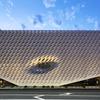More about Hulk (Organ)

Contributor
Jeff Koons’ Hulk (Organ) is, as its name suggests, equal parts Hulk and equal parts organ.
Koons wanted to explore the contrast of testosterone and masculinity, which the Hulk represents, when paired with either neutral or feminine symbols, neutralizing the binary so to speak. It’s a part of a larger series which Koons calls "Hulk Elvis," in which each piece features a giant Hulk like this one, placed with either toys, a wheelbarrow with living flowers, or the Liberty Bell.
Just think of how you react to the Hulk in any Marvel movie whenever he’s not bashing someone’s head in. When he conveys feelings, we find it intriguing. It means more because it’s so rare. Now strip the Incredible Hulk from the conversation and just look at masculinity as it exists in our society. So many of our problems in the world could be fixed if someone just gave these men a hug when they were kids and told them it was okay to feel things.
In addition to Koons’ exploration of gender norms, Koons believes Hulk (Organ) to represent both Western comic book culture, and Eastern guardian gods. He’s said that “They’re there as protectors, but at the same time they can become very, very violent…The Hulks are like that, they’re really high-testosterone symbols.”
Believe it or not, this Hulk isn’t a giant pool inflatable, no matter how much it looks like it. It’s actually created from polychromed bronze. It's not a replica of Mark Ruffalo’s cinematic version of the character, but of a toy. With this sense of playfulness, Koons once again challenges the notion of serious masculinity or violence, with something that represents joy and exuberance. In this case, the Hulk hulked out not only bulging muscles, but a keyboard, pipes, and pedals - giving sound to his bellowing anger. Literally. Hulk (Organ) is a fully functional musical instrument. It makes all the sounds an organ should make, just maybe not always in the right key - perhaps sounding more like the screaming green giant himself.
Sources
- The Art Story. “Jeff Koons Artworks.” Accessed August, 18, 2021. https://www.theartstory.org/artist/koons-jeff/artworks/
- Messham-Muir, Kit. “Jeff Koons – a spectacle on the way to respectable.” The Conversation. July 24, 2014. https://theconversation.com/jeff-koons-a-spectacle-on-the-way-to-respec…
- Wall Street International. “Jeff Koons. Hulk Elvis.” October 31, 2014. https://wsimag.com/art/11897-jeff-koons-hulk-elvis











